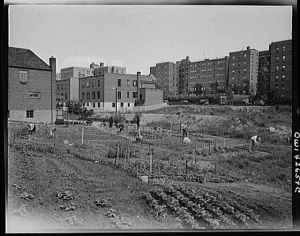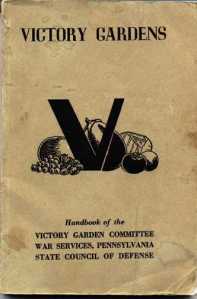I’ve been hearing recently about a proposed plan to plant and maintain a kitchen garden on the White House lawn. It would be a great way to spread the word about urban and kitchen gardening. Here’s a short article about the project by Roger Doiron, president of Kitchen Gardeners International.
Announce plans for a food garden on the White House lawn, making one of the White House’s eight gardeners responsible for it, with part of produce going to the White House kitchen and the rest to a local food pantry. The White House is “America’s House” and should set an example. The new President would not be breaking with tradition, but returning to it (the White House has had vegetable gardens before) and showing how we can meet global challenges such as climate change and food security.
It certainly would not be the first time there was agriculture at the White House. John Adams, the first president to occupy the White House, planted a vegetable garden there in 1800 (White House Historical Association). In 1835 Andew Jackson created the White House Orangery, an early type of greenhouse where tropical fruit trees and flowers can be grown, and added more trees, including the famous Jackson magnolia. The Orangery was later expanded into a greenhouse, which was torn down in 1857 to make way for the Treasury Department building.
Sheep on the White House Lawn, c. 1917. Library of Congress
The article below tells a little bit about White House vegetable gardens during the war effort.
Here is a longer article on the subject available at this link.
Message to the Next President: Eat the View
By Barbara Damrosch, published Thursday, February 28, 2007 in The Washington Post

I’ve been following the presidential campaign news, and I can’t believe no one has asked the big question: Which candidate will pledge to be the Gardening President? Who will be the one to take the lead in teaching food self-sufficiency and good nutrition to the American public? What a fine example it would set if the food miles traveled by presidential produce added up to zero.
Chef and food activist Alice Waters made headlines in 2000 by urging President Bill Clinton to plant a vegetable garden at the White House. “Send me the seeds, Alice” was his answer, as quoted in the St. Petersburg Times. But the plan was deemed out of keeping with the grounds’ formal style, and nothing came of it. Perhaps Hillary Clinton, if elected, would be willing to see it through.
The idea certainly has historical precedent. Both George Washington and Thomas Jefferson were dedicated farmers. According to William Seale, author of “The White House Garden,” the first kitchen garden at 1600 Pennsylvania Avenue was installed by President John Adams in 1800 — to cut household expenses.
I contacted Rose Hayden-Smith, an expert on the history of wartime gardening and agriculture programs during both world wars, and she highlighted some of the first families’ efforts in the last century. Woodrow Wilson’s second wife, Edith, “raised sheep on the former White House lawn during World War I as part of the White House’s war mobilization effort,” Hayden-Smith noted. “Eleanor Roosevelt was a Victory Gardener, and grew beans and carrots on what had been the White House Lawn. This was going on by 1943. She inspired millions of other home gardeners in their efforts.” Jimmy Carter, another farmer at heart, paid particular attention to the herb garden.
Perhaps the time has come to bring back the Victory Garden in a new guise: as a war on childhood obesity, inactivity, addiction to highly processed food with empty calories, and the use of fossil fuels to grow and ship us our meals.
Roger Doiron, the director of Kitchen Gardeners International ( http://www.kitchengardeners.org), had a great suggestion: “We give tax breaks to people to encourage them to put hybrid cars in their garages and solar panels on their roofs, so why not a tax break to encourage environmentally friendly and healthy food production?” He likened his plan to deducting the square footage of a home office: the bigger your garden, the better the tax break. Those with no yard could deduct the rental fee for a community garden plot.
That would be one small step toward a healthier nation. But it would get my vote.
—–
For an additional comment from KGI’s Roger Doiron on this topic, please click here.
To cast your vote in favor of a new garden on the White House lawn, please go here and click on “rate this idea”.
Article copyright of Barbara Damrosch. Reprinted with permission.
If you are interested in contributing to the campaign you can do that here.















































